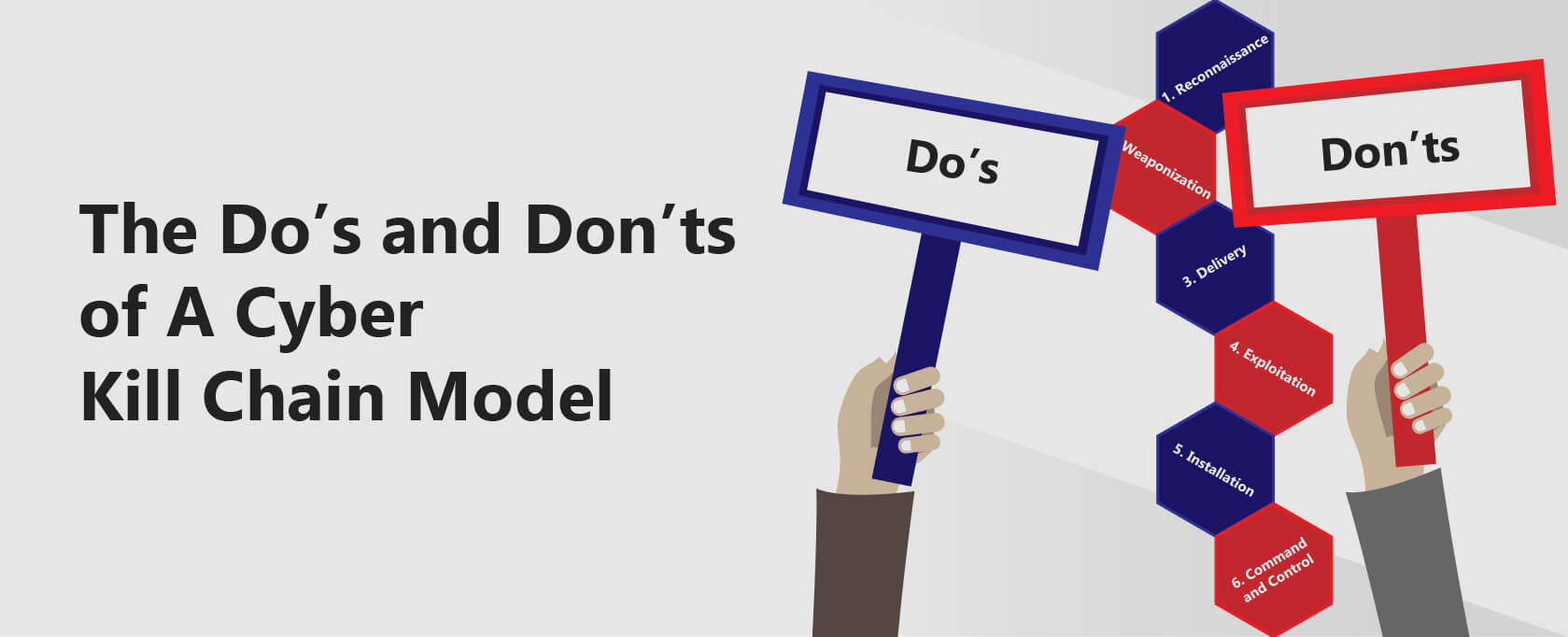The Do’s and Don’ts of A Cyber Kill Chain Model
Cybersecurity has long since relied on the “castle and moat” analogy. While it has done a relatively decent job of protecting enterprises from generic cyber attacks, cybersecurity now demands an evolution.
The cyber threat landscape is constantly ebbing and flowing, with cybercriminals getting more sophisticated with each minute.
Besides, integrating hybrid working models implementing the frequent use of remote cloud storage and unprotected data transmission has weakened cybersecurity.
Admittedly, organizations do a reasonably decent job nowadays of ensuring endpoint security; however, the sophistication of modern cyber-attacks demands a more layered approach.
It is, therefore, the reason why Lockheed Martin’s cyber kill model has rapidly evolved to become one of the most in-demand cybersecurity solutions.
The layered security model helps security teams implement robust cybersecurity within organizations by building strategies for identifying and stopping cyber attacks.
Originally inspired by military strategy, this model has been adapted to outline the sequential phases of a cyber attack. Understanding these seven phases helps security teams better identify, disrupt, and neutralize threats.
The framework emphasizes the vital role of human involvement in cybersecurity, highlighting the need for a well-informed and vigilant workforce.
By integrating the Cyber Kill Chain framework with a multi-layered defense strategy, organizations can significantly enhance their cybersecurity defenses and protect against sophisticated cyber threats.
What is the Cyber Kill Chain?
The term “Kill Chain” is originally a military term used to describe the various stages in which an enemy launches an attack over its target. In 2011, Martin Lockheed used this term to define this model, which helped outline the various steps in which the modern cyber attack proceeds.
According to the model, a typical modern cyberattack occurs in seven stages. In theory, the model’s seven stages of the attack can help security teams better understand the process, enabling them to detect and stop the attack at respective stages.
The more points at which security teams intercept the threat actors within an attack procedure, the better chance these teams have at protecting, detecting, and even delaying a cyber attack.
While several other Cyber Kill Chain Models have sprung up after Martin Lockheed’s model, it still surpasses in value in contrast to the others.
The reason is that the Martin Lockheed model focuses on the humanistic element of a cyberattack. It is a crucial element to consider within a world where social engineering attacks remain a constant threat.
The humanistic element within a cyber attack has long since faced neglect. Despite social engineering attacks being one of the most common attack vectors for various APTs, the humanistic element meets gross negligence probably because of the standard misconceived view of cybersecurity being “technology-centric.”
However, Martin Lockheed’s Cyber Kill Chain Model focuses on the humanistic element and is very informative on how it addresses the cyber kill chain model.
Understanding and implementing the Cyber Kill Chain Model
There are seven main stages of a cyber kill chain model that must be appropriately implemented to neutralize, detain, or stop a cyber attack in the best ways possible.
A descriptive overview of the requirements and working of these stages are as follows:
1. Reconnaissance
The threat actor gathers information on the target before launching the actual attack. The threat actor collects data from social networking platforms such as Facebook, LinkedIn, or Instagram.
The attacker might also collect information through social engineering techniques such as calling employees, carrying out email interactions, or even dumpster diving.
While it may seem that security teams can do little to prevent the attack, employee behaviors play a crucial role in this stage.
Suppose the organization has employees well aware of social engineering tactics and is vigilant about the amount of information to share over social media platforms and with customer, client, or vendor prospects. In that case, the organization can stop the attack from occurring.
Moreover, any organization following a safety protocol for disposing sensitive documents and ensuring safe communication over phone calls can also significantly ward off damage.
While such measures might not completely neutralize this stage, they can either help the security team pump up its defense or somewhat thwart the threat actor’s attempts.
2. Weaponization
After gathering all the relevant intel about the target, the attacker proceeds with creating the attack. The attack would range depending upon the intended damage by the attack.
It could either be malware explicitly launched to steal data, a ransomware attack designed to gain money, a business email compromise attack, or even a whaling attack.
The attack can be designed in various ways, from phishing emails to infected USB drives and malicious Microsoft document attachments.
Depending upon the security awareness and the use of endpoint security tools, the security team can neutralize the attack at this stage unless the threat actor follows a testing protocol on the target to penetrate past such intermediate defenses.
3. Delivery
This stage outlines the transmission of an attack over the intended victim such that it could involve launching the phishing email or planting a USB drive to attract the victim.
Like in the first stage, people play a critical role, despite the availability of several tools to stop attacks at this stage.
Most of the major attack vectors found in various reports are weak passwords and phishing, which revolve around people.
An attacker can successfully infiltrate a system due to vulnerable password security through a successful social engineering tactic; therefore, proper awareness of such an attack vector can significantly reduce this attack.
However, the problem remains as technology instead of people is taken as the first line of defense.
4. Exploitation
Once the attack is delivered, it exploits the vulnerabilities present within the system or the network. If it is a ransomware attack, it will sneakily encrypt all the data present within the devices throughout the organization and hold it hostage for ransom.
An organization facing an attack is often a high-alert situation. Still, security teams can avoid it by deploying proper security awareness to the employees, producing an effective incident response plan, carrying out regular penetration testing and vulnerability scanning, and ensuring endpoint security through various tools.
5. Installation
This phase of an attack implies an attack actively exploiting a running system or a network. At this stage, the threat actor would look for additional vulnerabilities or the availability of privilege escalation to further gain access to the system and sneakily install backdoors and remote access trojans to allow easy execution of future attacks.
Since these backdoors might get detected, the attacker might also deploy various obfuscation techniques to conceal their presence and avoid detection.
The techniques could include:
- Wiping files and metadata.
- Modifying critical information to make it seem secure and untouched.
- Overwriting digital footsteps with false timestamps.
- Misleading information.
Defense at this stage would involve an active compromise assessment plan, understanding the attack, and using various endpoint security tools and techniques for detecting and logging installation activity.
6. Command and Control
Now that the threat actor has infiltrated the network, it connects to an external server to establish a command and control channel.
Establishing this connection allows the threat actor to have complete access to the target network. This stage is the security team’s last best chance to sabotage and stop the cyber attack.
If the security team manages to block the adversaries from issuing commands, they can successfully prevent significant impacts of the launched attacks.
Defense at this step involves conducting a malware analysis and figuring out the command and control network. Apart from that, security teams can also conduct open-source research of the network infrastructure and make proxies mandatory for all types of internet traffic.
Actions on Objectives
Progression through the six steps mentioned above of the cyber kill chain is how a threat actor can manage to launch a cyber attack. A typical cyber-attack aims to destroy an organization for financial or informational gain.
To achieve such objectives, the attackers go through these steps to gain access to systems and penetrate deep within networks to fully launch an attack that will cause the highest levels of damage.
Understanding all the six stages of the cyber kill chain model can help the security teams implement relevant security strategies and stop the attack midway.
Moreover, if the attacker successfully launched the attack, the security team should have specific security measures to take action and gain back control.
Even at the seventh stage, the security team can protect the organization from dire harm by establishing a robust incident response plan to detect data exfiltration and compromise credentials and conduct a proper investigation and damage assessment of the incident.
Conclusions
Cybersecurity is a holistic approach that requires an in-depth evaluation of security endpoints, vulnerabilities, and network security infrastructures to ensure robust cybersecurity.
The cyber kill model provides a layered overview of a cyber actor’s strategy. The model somewhat allows the security teams to play the game by the threat actors’ playbook, which helps them better understand the attack vectors and build a defense system accordingly.


